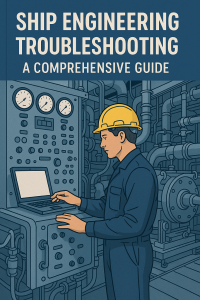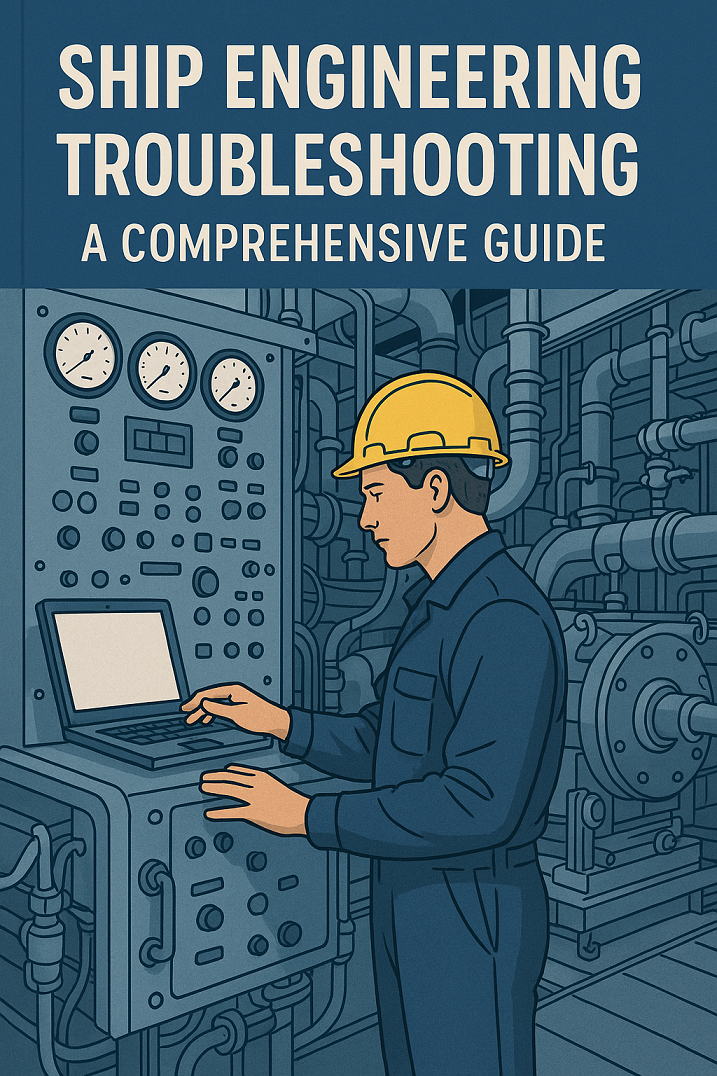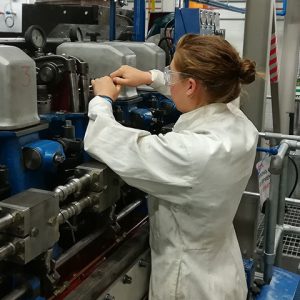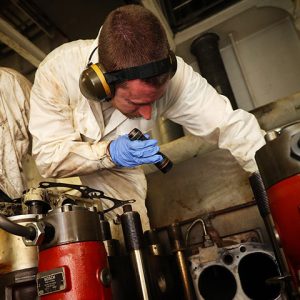
Explore in-depth troubleshooting techniques for marine engine room systems, including cooling, lubrication, and electrical systems, to enhance ship safety and efficiency.
In the vast expanse of the ocean, a ship’s engine room serves as its heart, ensuring seamless voyages across continents. However, like any complex machinery, marine systems are susceptible to malfunctions. Effective troubleshooting is paramount to address these issues promptly, ensuring safety, efficiency, and compliance with maritime regulations.
This article delves into the intricacies of troubleshooting key marine engine room systems, offering insights for beginners, students, professionals, and general readers alike.
Understanding Marine Engine Room Systems
The engine room houses various systems working in tandem to propel the ship and support onboard operations. Key systems include:
-
Main Engine Jacket Cooling Water System: Regulates engine temperature by circulating coolant.
-
Cylinder Lubrication System: Reduces friction and wear in engine cylinders.
-
Lube Oil System: Lubricates moving parts and removes contaminants.
-
Sea Water Cooling System: Utilizes seawater to dissipate heat from various systems.
-
Electrical Supply and Emergency Generator Systems: Provide power for operations and backup during outages.
Understanding these systems’ functions is crucial for effective troubleshooting and maintenance.
Common Troubleshooting Techniques
Troubleshooting involves systematic approaches to identify and rectify issues. Key techniques include:
1. Visual Inspection
Regularly inspect systems for signs of wear, leaks, or damage. Early detection can prevent major failures.
2. Monitoring Operational Parameters
Track temperature, pressure, and flow rates to identify anomalies indicating potential problems.
3. Diagnostic Tools
Utilize tools like vibration analyzers and thermal cameras to detect issues not visible to the naked eye.
4. Maintenance Records Review
Analyze past maintenance logs to identify recurring issues and their solutions.
Troubleshooting Specific Systems
Main Engine Jacket Cooling Water System
Container shipping disruptions have increased demand for efficient cooling systems. Common issues in the main engine jacket cooling water system include overheating from coolant leaks, pump failures, or blockages. Regular checks of coolant levels, pump functionality, and cleaning cooling passages can prevent breakdowns and costly delays.
Common Issues:
- Overheating due to coolant leaks or pump failures.
- Blockages in cooling passages.
Troubleshooting Steps:
- Check coolant levels and inspect for leaks.
- Ensure pumps are operational and free from obstructions.
- Clean cooling passages to remove blockages.
Cylinder Lubrication System
Rising freight costs make maintenance critical. The cylinder lubrication system often faces problems like insufficient lubrication and contaminated oil, leading to engine wear. Inspecting lubricant quality, checking for blockages, and ensuring pump efficiency can extend engine life and reduce downtime.
Common Issues:
- Inadequate lubrication leading to increased wear.
- Contaminated lubricants causing corrosion.
Troubleshooting Steps:
- Verify lubricant quality and replace if contaminated.
- Inspect lubrication lines for blockages or leaks.
- Ensure proper functioning of lubrication pumps.
Lube Oil System
Fluctuating oil prices mirror pressure issues in lube oil systems. Contamination with water or fuel and unstable pressure are common concerns. Routine oil analysis, filter replacements, and pressure monitoring help maintain smooth operations and avoid engine damage.
Common Issues:
- Oil pressure fluctuations.
- Oil contamination with water or fuel.
Troubleshooting Steps:
- Monitor oil pressure and investigate anomalies.
- Conduct oil analysis to detect contaminants.
- Replace oil filters and address sources of contamination.
Sea Water Cooling System
Global trade growth strains cooling systems. Marine growth buildup and pump failures reduce efficiency in seawater cooling systems. Regular cleaning of strainers, heat exchangers, and pump maintenance ensures optimal performance and prevents overheating.
Common Issues:
- Reduced cooling efficiency due to marine growth.
- Pump failures leading to inadequate water flow.
Troubleshooting Steps:
- Clean sea strainers and heat exchangers regularly.
- Inspect and maintain pumps to ensure optimal performance.
Electrical Supply and Emergency Generator Systems
Supply chain reliability depends on backup power. Generator failures and faulty wiring can cause dangerous outages. Load testing generators, inspecting electrical connections, and adhering to safety standards keep vessels operational during critical moments.
Common Issues:
- Power outages due to generator failures.
- Faulty wiring causing electrical hazards.
Troubleshooting Steps:
- Test generators under load conditions to ensure reliability.
- Inspect wiring for signs of wear or damage.
- Ensure compliance with electrical safety standards.
Advanced Troubleshooting Strategies
For complex issues, advanced strategies may be employed:
-
Root Cause Analysis: Identify underlying causes of recurring problems to implement long-term solutions.
-
Predictive Maintenance: Use data analytics to predict failures before they occur, allowing for proactive maintenance.
-
Training and Simulation: Utilize simulators to train engineers in handling emergency scenarios and system failures.
Importance of Documentation and Compliance
Maintaining accurate records of maintenance and troubleshooting activities is vital for:
-
Regulatory Compliance: Ensures adherence to maritime regulations and standards.
-
Performance Monitoring: Tracks system performance over time to identify trends.
-
Knowledge Sharing: Facilitates information transfer among crew members and during handovers.
Conclusion
Effective troubleshooting of marine engine room systems is essential for the safety and efficiency of maritime operations. By understanding system functions, employing systematic troubleshooting techniques, and maintaining thorough documentation, marine engineers can address issues promptly and prevent costly downtimes.
Explore Further:
FAQs
Q1: What are common signs of engine room system failures?
A1: Indicators include unusual noises, vibrations, temperature fluctuations, and alarms signaling parameter deviations.
Q2: How often should maintenance checks be performed?
A2: Regular checks should be conducted daily, with comprehensive inspections aligned with the vessel’s maintenance schedule.
Q3: What tools are essential for troubleshooting?
A3: Essential tools include multimeters, pressure gauges, thermal cameras, and vibration analyzers.
Q4: How does predictive maintenance benefit marine operations?
A4: Predictive maintenance anticipates failures, allowing for timely interventions, reducing downtime, and optimizing resource allocation.
References & Further Reading:
-
Marine Engineering Troubleshooting Guide
-
Marine Insight’s comprehensive resource on engine room systems and troubleshooting techniques
-
-
Electrical Systems for Marine Engineers
-
Routledge’s professional reference book on marine electrical systems
-
-
IMO Engine Room Safety Guidelines
-
International Maritime Organization’s official safety standards for engine rooms
-
-
Practical Marine Electrical Knowledge
-
Witherby Seamanship International’s technical publications
-
-
Marine Lubrication Systems Handbook
-
Technical guide to marine lubrication system maintenance
-
-
Cooling System Maintenance for Marine Engines
-
Wärtsilä’s technical encyclopedia entry on marine cooling systems
-
-
Predictive Maintenance in Marine Engineering
-
SKF’s marine solutions for predictive maintenance technologies
-
-
Emergency Generator Testing Procedures
-
DNV’s marine technical publications including electrical system guidelines
-
Explore Further:
Note: Some links go to publisher/product pages rather than direct PDFs to avoid potential copyright issues. For academic/scholarly sources, you may want to add:
-
Marine Engineering Research Papers
-
ScienceDirect’s collection of peer-reviewed marine engineering papers
-
-
-
U.S. Coast Guard’s technical reference materials
-




Many thanks, from a ship engineer 📚👍
Thanks, actually I like this post 🙂